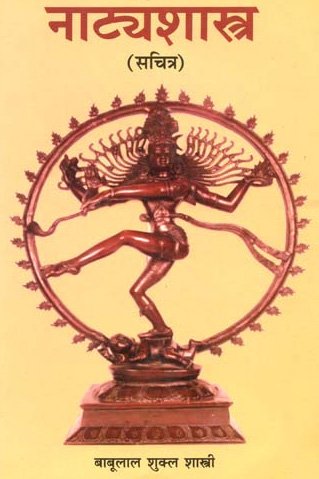Sapatni, Sapatnī: 13 definitions
Introduction:
Sapatni means something in Hinduism, Sanskrit, Marathi, Hindi, Tamil. If you want to know the exact meaning, history, etymology or English translation of this term then check out the descriptions on this page. Add your comment or reference to a book if you want to contribute to this summary article.
In Hinduism
Natyashastra (theatrics and dramaturgy)
Source: archive.org: The mirror of gesture (abhinaya-darpana)Sapatnī (सपत्नी, “co-wife”).—One of the Eleven Hands denoting Relationships.—(Instructions:) The Pāśa hand is shown first, and then Strī with both hands.

Natyashastra (नाट्यशास्त्र, nāṭyaśāstra) refers to both the ancient Indian tradition (shastra) of performing arts, (natya—theatrics, drama, dance, music), as well as the name of a Sanskrit work dealing with these subjects. It also teaches the rules for composing Dramatic plays (nataka), construction and performance of Theater, and Poetic works (kavya).
General definition (in Hinduism)
Source: archive.org: Vedic index of Names and SubjectsSapatnī (सपत्नी) occurs in the Rigveda in the sense of ‘co-wife’; in the first and the last Maṇḍalas it means co-wife as a ‘rival’. In post-Vedic Sanskrit the word becomes a synonym for ‘rival’.
Languages of India and abroad
Marathi-English dictionary
Source: DDSA: The Molesworth Marathi and English Dictionarysapatnī (सपत्नी).—f (S sa for samāna, & pati. Female having the same lord.) A fellow-wife, a rival-wife.
Source: DDSA: The Aryabhusan school dictionary, Marathi-Englishsapatnī (सपत्नी).—f A rival-wife, a fellow-wife.
Marathi is an Indo-European language having over 70 million native speakers people in (predominantly) Maharashtra India. Marathi, like many other Indo-Aryan languages, evolved from early forms of Prakrit, which itself is a subset of Sanskrit, one of the most ancient languages of the world.
Sanskrit dictionary
Source: DDSA: The practical Sanskrit-English dictionarySapatnī (सपत्नी).—[samānaḥ patiryasyāḥ sā] A rival or fellow wife, rival mistress, co-wife (having the same husband with another); दिशः सपत्नी भव दक्षिणस्याः (diśaḥ sapatnī bhava dakṣiṇasyāḥ) R.6.63;14.86; कुरु प्रियसखीवृत्तिं सपत्नीजने (kuru priyasakhīvṛttiṃ sapatnījane) Ś.4.17.
Source: Cologne Digital Sanskrit Dictionaries: Benfey Sanskrit-English DictionarySapatnī (सपत्नी).—f. a wife whose husband has other wives,
— Cf. .
Sapatnī is a Sanskrit compound consisting of the terms sa and patnī (पत्नी).
Source: Cologne Digital Sanskrit Dictionaries: Cappeller Sanskrit-English DictionarySapatnī (सपत्नी).—[feminine] having the same lord or husband, fellow-wife or mistress; also = seq.
Source: Cologne Digital Sanskrit Dictionaries: Monier-Williams Sanskrit-English Dictionary1) Sapatnī (सपत्नी):—[=sa-patnī] [from sa > sa-pakṣa] a See sub voce
2) [=sa-patnī] [from sa-patna] 1. sa-patnī f. (once in [Rāmāyaṇa] tni) a woman who has the same husband with another woman ([Pāṇini 4-1, 35]) or whose husband has other wives, a fellow-wife or mistress, female rival, [Ṛg-veda]; etc.
3) [=sa-patnī] [from sa-patna] 2. sa-patnī mfn. = next, [Rāmāyaṇa]
Source: DDSA: Paia-sadda-mahannavo; a comprehensive Prakrit Hindi dictionary (S)Sapatnī (सपत्नी) in the Sanskrit language is related to the Prakrit words: Sauttī, Savattī, Sāvakkā.
[Sanskrit to German]
Sanskrit, also spelled संस्कृतम् (saṃskṛtam), is an ancient language of India commonly seen as the grandmother of the Indo-European language family (even English!). Closely allied with Prakrit and Pali, Sanskrit is more exhaustive in both grammar and terms and has the most extensive collection of literature in the world, greatly surpassing its sister-languages Greek and Latin.
Hindi dictionary
Source: DDSA: A practical Hindi-English dictionarySapatnī (सपत्नी):—(nf) a co-wife; ~[ka] along with one’s wife.
...
Kannada-English dictionary
Source: Alar: Kannada-English corpusSapatni (ಸಪತ್ನಿ):—[noun] one of the two wives of a man, as related to another (wife); a fellow wife.
--- OR ---
Sāpatni (ಸಾಪತ್ನಿ):—
1) [noun] one of the two wives of a man, as related to another (wife); a fellow wife.
2) [noun] (fig.) a woman who hates or is hated by, intensly another woman.
Kannada is a Dravidian language (as opposed to the Indo-European language family) mainly spoken in the southwestern region of India.
Tamil dictionary
Source: DDSA: University of Madras: Tamil LexiconSapatni (ஸபத்நி) noun < sa-patnī. Co-wife; சக்களத்தி. [sakkalathi.]
Tamil is an ancient language of India from the Dravidian family spoken by roughly 250 million people mainly in southern India and Sri Lanka.
See also (Relevant definitions)
Partial matches: Patni, Sha, Ca.
Starts with: Sapatnibadhana, Sapatniduhitri, Sapatnijana, Sapatnika, Sapatnikar, Sapatnikrita, Sapatniputra, Sapatnisha, Sapatnispardha, Sapatnitas, Sapatnitva.
Ends with: Dasapatni, Kritasapatni, Tryakshapatni, Upasapatni, Vrishapatni.
Full-text (+13): Sapatnitva, Sapatna, Upasapatni, Naganimnaga, Sapatnika, Sapatnijana, Sapatnispardha, Sapatniputra, Sapatnibadhana, Savakka, Sapatnitas, Sapatniduhitri, Sapatnya, Sapatnisha, Cavatti, Cautti, Savatti, Sautti, Sapatnikrita, Kritasapatnika.
Relevant text
Search found 12 books and stories containing Sapatni, Sapatnī, Sa-patni, Sa-patnī, Sāpatni, Sapathni, Sapadni, Sapadhni; (plurals include: Sapatnis, Sapatnīs, patnis, patnīs, Sāpatnis, Sapathnis, Sapadnis, Sapadhnis). You can also click to the full overview containing English textual excerpts. Below are direct links for the most relevant articles:
Rig Veda (translation and commentary) (by H. H. Wilson)
Hari-bhakti-kalpa-latikā (by Sarasvati Thkura)
Text 34 < [Second Stabaka]
Garga Samhita (English) (by Danavir Goswami)
Verse 2.18.7 < [Chapter 18 - The Sight of Śrī Kṛṣṇacandra]
Verse 5.18.14 < [Chapter 18 - Uddhava Hears the Gopīs’ Words and Returns to Mathurā]
Verse 6.17.17 < [Chapter 17 - Śrī Śrī Rādhā and Kṛṣṇa Meet at Siddhāśrama and the Nature of Śrī Rādhā’s Love Is Revealed]
Abhinaya-darpana (English) (by Ananda Coomaraswamy)
Harshacharita (socio-cultural Study) (by Mrs. Nandita Sarmah)
Part 8: Polygamy < [Chapter 4 - Status of Women]
Vasudevavijaya of Vasudeva (Study) (by Sajitha. A)
Strīpratyaya (Feminine affixes) < [Chapter 3 - Vāsudevavijaya—A Grammatical Study]